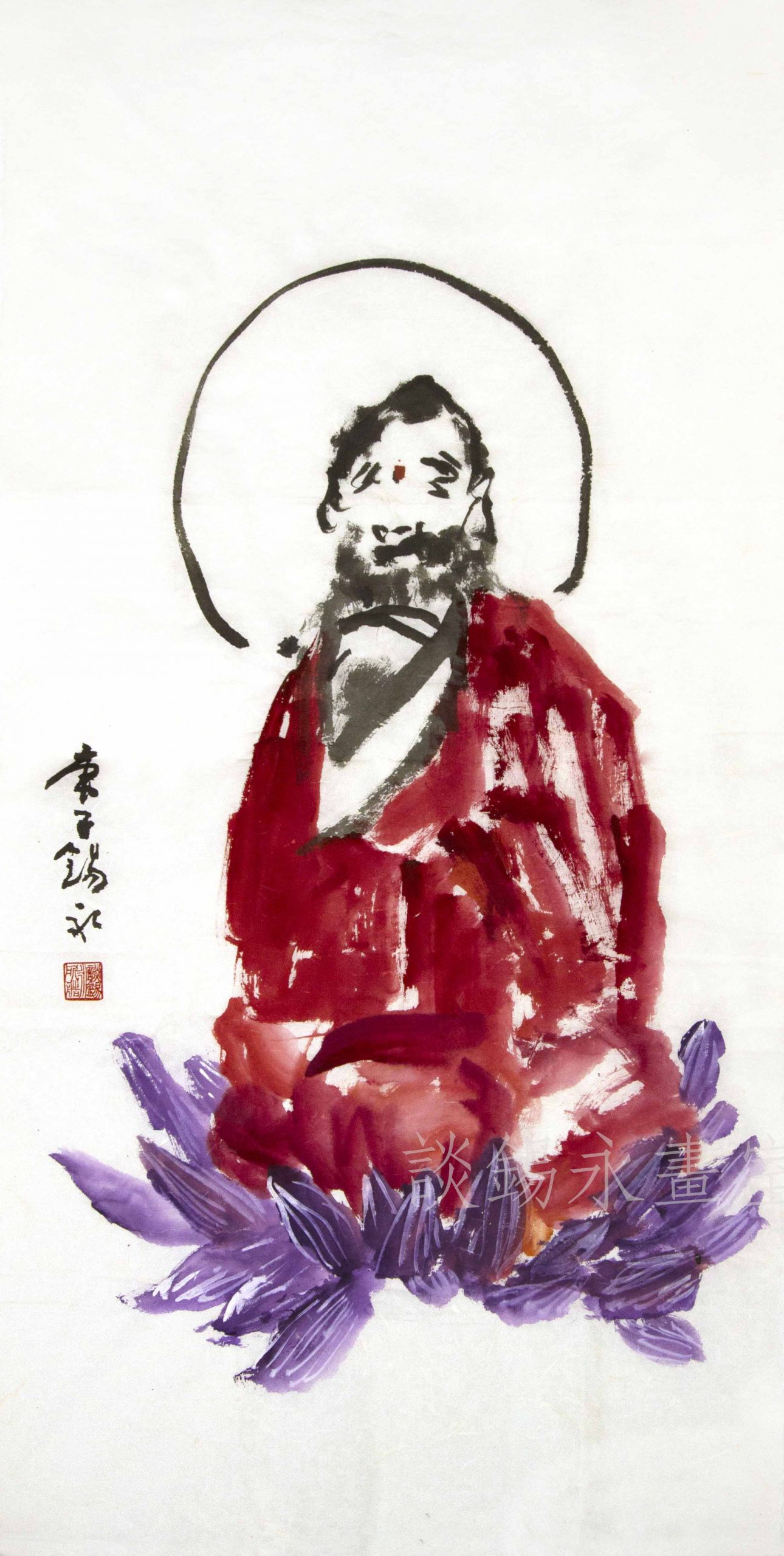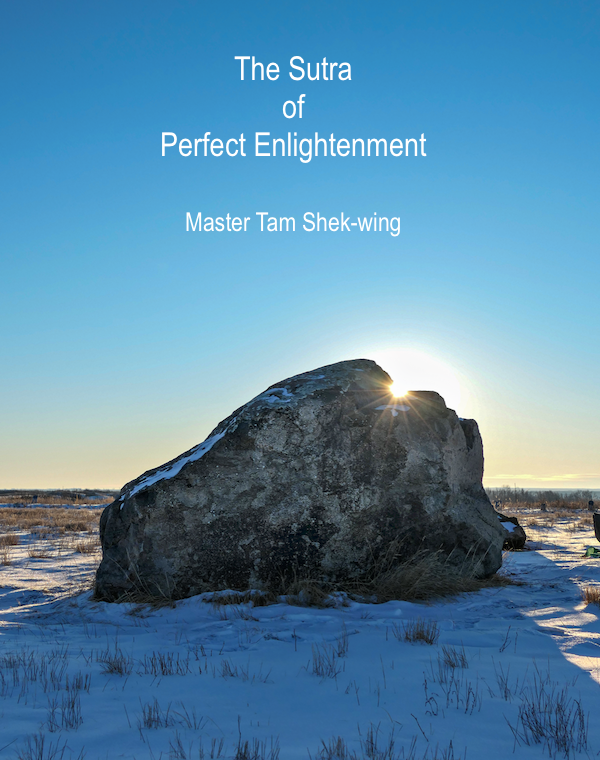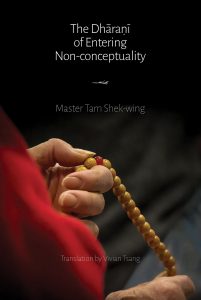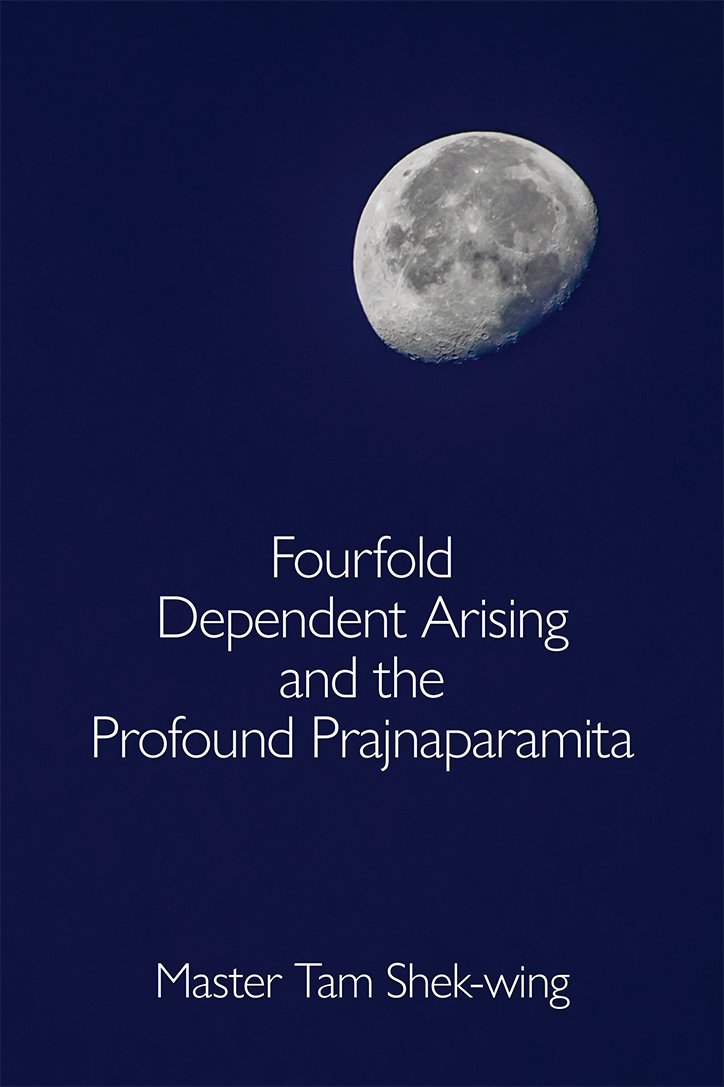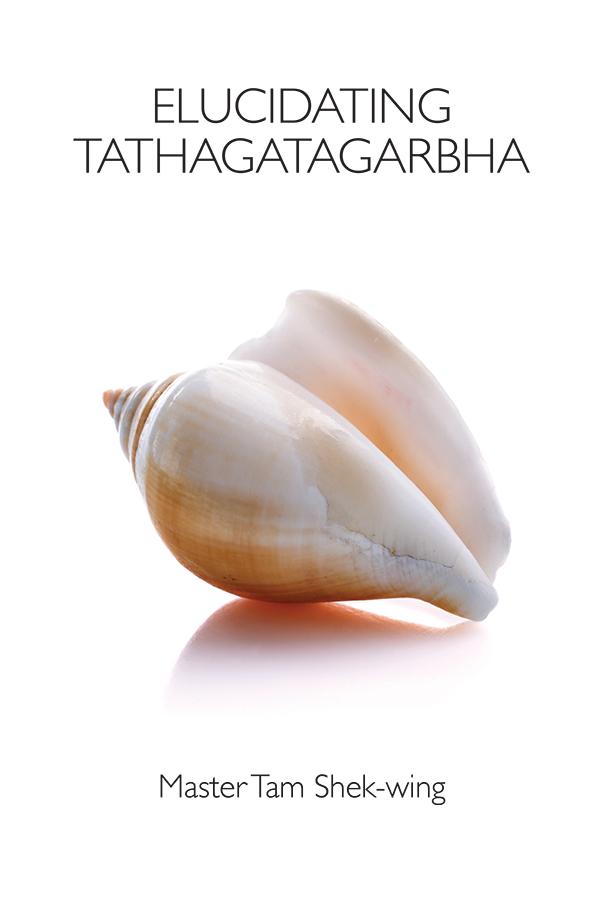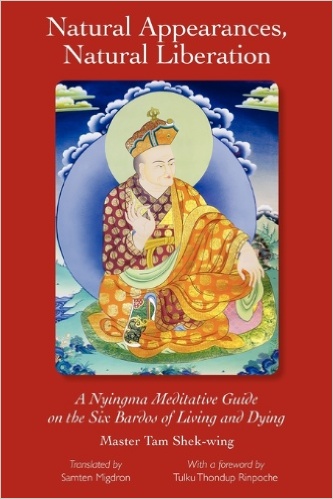Perfect Enlightenment 12: Buddha Continues, On Observing Dharmadhātu
Show scripture (Chinese). 「善男子!此菩薩及末世眾生,證得諸幻滅影像故,爾時便得無方清淨,無邊虛空覺所顯發。覺圓明故顯心清淨,心清淨故見塵清淨,見清淨故眼根清淨,根清淨故眼識清淨,識清淨故聞塵清淨,聞清淨故耳根清淨,根清淨故耳識清淨,識清淨故覺塵清淨;如是乃至鼻、舌、身、意亦復如是。善男子!根清淨故色塵清淨,色清淨故聲塵清淨,香、味、觸、法亦復如是。 「善男子!六塵清淨故地大清淨,地清淨故水大清淨,火大、風大亦復如是。善男子!四大清淨故,十二處、十八界、二十五有清淨。彼清淨故,十力、四無所畏、四無礙智、佛十八不共法、三十七助道品清淨,如是乃至八萬四千陀羅尼門一切清淨。善男子!一切實相性清淨故一身清淨,一身清淨故多身清淨,多身清淨故如是乃至十方眾生圓覺清淨。善男子!一世界清淨故多世界清淨,多世界清淨故如是乃至盡於虛空圓裹三世一切平等清淨不動。 「善男子!虛空如是平等不動,當知覺性平等不動;四大不動故,當知覺性平等不動;如是乃至八萬四千陀羅尼門平等不動,當知覺性平等不動。善男子!覺性遍滿清淨不動。圓無際故,當知六根遍滿法界;根遍滿故,當知六塵遍滿法界;塵遍滿故,當知四大遍滿法界;如是乃至陀羅尼門遍滿法界。善男子!由彼妙覺性遍滿故,根性、塵性無壞無雜;根、塵無壞故,如是乃至陀羅尼門無壞無雜;如百千燈光照一室,其光遍滿無壞無雜。 Show scripture (English). “Good sons, because these bodhisattvas and sentient beings of the degenerate age fully witness all illusion and dispel all images, they immediately experience limitless purity.” “Good sons, enlightenment reveals limitless space. Since enlightenment is perfectly clear, the manifest mind is pure. Since the mind is pure, the objects of vision are pure. Since vision is pure, the eye faculty is pure. Since the eye faculty is pure, the visual consciousness is pure. Since this consciousness is pure, hearing is pure. Since hearing is pure, the ear faculty is pure. Since the faculty is pure, the auditory consciousness is pure. Since the consciousness is pure, all perception is pure, and so it is true for smell, taste, touch and conceptualization as well.” “Good sons, since the eye faculty is pure, the colour spectrum is pure. Since color is pure, the field of sound is also pure. The same is true of the fields of smell, taste, touch and thought.” “Good sons, since the six objects are pure, the Earth element is pure. Since Earth is pure, Water is pure, and so are Fire and Wind. Good sons, since the Four Elements are pure, the Twelve Loci, the Eighteen Realms and the Twenty-Five Kinds of Existence are pure. Since these are pure, the Ten Powers, the Four Kinds of Fearlessness, the Four Types of Unobstructed Wisdom, the Buddha’s Eighteen Distinctive Characteristics, and the Thirty- seven Aids to Enlightenment are pure, and so on up to the Eighty-four thousand dhāraṇī-entrances, everything is pure.” “Good sons, since all true marks are pure in their nature, one body is pure. Since one body is pure, many bodies are pure. Since many bodies are pure the same is true of all sentient beings in the ten directions, who are perfectly enlightened and pure. Good sons, since one world is pure, many worlds are pure. Since many worlds are pure, we can see that throughout all of space, completely including the three times, all things are equal, pure and changeless.” “Good sons, since space is equal and changeless, you should know that the nature of enlightenment is equal and changeless. Since the Four Elements are changeless, you should know that the nature of enlightenment is equal and changeless. The same holds true all the way up through the 84,000 dhāraṇī-entrances which are equal and changeless. Therefore, you should know that the nature of enlightenment is equal and changeless.” “Good sons, the unchanging purity of the nature of enlightenment completely pervades—it includes everything without restriction. Therefore, you should know that the six faculties completely pervade the realm of reality. Since the faculties completely pervade, you should know that the six sensory fields completely pervade the realm of reality. Since the sensory fields completely pervade, you should know that the Four Elements completely pervade the realm of reality. It is the same way with all things, including the dhāraṇī-entrances, which completely pervade the realm of reality.” “Good sons, since this marvelous nature of enlightenment completely pervades, there is neither conflict nor confusion between the natures of the faculties and their objects. Since the faculties and objects have no conflict, it is like this through all of existence, including in the dhāraṇī-entrances, which have neither conflict nor confusion. It is like one hundred thousand lamps shining in one room. Their light completely pervades without conflict or confusion.” The ultimate quiescence of illusion is the attainment of purity. This realm of purity is also the dharmadhātu. And yet, this realm is still capable of manifesting illusion – upon dharmakaya is the spontaneous dependent arising of all consciousness realms. Buddha used the mani-jewel as an analogy. A multi-faceted jewel can reflect many colour lights, but these reflections are none other than illusion. The ignorant would say the jewel itself possesses these colours. Nowadays, the crystal makes an apt metaphor for it can reflect many colour lights, but it does not possess them. At one angle, it may appear red; at another, blue. It becomes clear that neither red nor blue is the colour of the crystal itself. In fact, all conventional manifestations are not the true appearance of dharmadhātu, they are only illusory. Observing the crystal in the dark, it does not reflect coloured lights – it is a cessation of illusory appearances, which is the pure appearance of the crystal. Similarly, the perfectly enlightened marvelous mind is where there is an awareness of dharmadhātu. Here, the scripture begins by saying that the body and mind of bodhisattvas manifest in dharmadhātu, this illustrates bodhisattvas’ realization of wisdom in dharmadhātu. With this wisdom realization, body and mind are seen to have the nature of the perfectly enlightened marvelous mind, transcending the obscuration from all illusory appearances. This is analogous to observing the shimmer of a crystal, one does not become attached to this sparkle as red, or that sparkle as blue, for they are both illusory. Grasping at what sparkle is what colour is already an attachment to the illusory contamination. Knowing that regardless of colour, they are all spontaneous dependent arising, they are illusory but not reality. By changing the point-of-view, what appeared as red before may now appear blue, and vice versa, thereby gaining a glimpse of the true appearance of the crystal. This is called becoming free from the illusory contamination. Such illusory contaminations do not exist primordially in dharmadhātu, they are consciousness’ fabrications within dharmadhātu that manifest as illusions. Illusions fabrications of the mind can also be dispelled (liberated). Subsequent to the mind becoming free of illusory obscuration is three layers of judgements to arrive at a certainty on dharmadhātu. On the first layer of judgements... click to show more. The first layer is the detachment from language. According to the stages in the scripture, from the attainment of perfect awareness, one can determine the purity of one’s mind. From the purity of one’s mind, one can determine the purity of six objects. With the twofold purity comes the purity of subject and object. Awareness is no longer constrained by the duality of subject and object, for there is no longer the grasping mind, nor are there the six objects to be grasped at. From the purity of mind comes the purity of six faculties. From the purity of six faculties, the purity of six consciousnesses is revealed. From the purity of the six objects, the purity of the four elements is also revealed. With the purity of the four elements, the twelve places, the eighteen realms, twenty-five existences are also pure. The twenty-five existences refer to all mundane worlds (beings and the three realms). If all mundane worlds are pure, then all transcendent phenomena such as “the Ten Powers, the Four Kinds of Fearlessness, the Four Types of Unobstructed Wisdom, the Buddha’s Eighteen Distinctive Characteristics, and the Thirty- seven Aids to Enlightenment are pure, and so on up to the Eighty-four thousand dhāraṇī-entrances, everything is pure.” What is said as pure is a purity from transcending words and meaning. By transcending words and meaning is also a transcendence of conceptuality and intentions. The scripture continues, “[S]ince all true marks are pure in their nature, one body is pure. Since one body is pure, many bodies are pure. Since many bodies are pure the same is true of all sentient beings in the ten directions, who are perfectly enlightened and pure.” Generalizing further, one can generalize from body to the world, “Since one world is pure, many worlds are pure. Since many worlds are pure, we can see that throughout all of space, completely including the three times, all things are equal, pure and changeless.” Here, to say “throughout all of space,” it means pervading all boundaries; to say “completely including the three times,” it means transcending the three times of past, present, and future. If space and time are also awareness via the perfect enlightenment, this is a realization entering the nature of purity and great equality that is beyond words and unchanging, the entrance to dharmadhātu. On the second layer... click to show more. Via the entrance to dharmadhātu, what is the nature of this awareness? The scripture says, “[S]ince space is equal and changeless, you should know that the nature of enlightenment is equal and changeless. Since the Four Elements are changeless, you should know that the nature of enlightenment is equal and changeless. The same holds true all the way up through the 84,000 dhāraṇī-entrances which are equal and changeless. Therefore, you should know that the nature of enlightenment is equal and changeless.” From the equality and changelessness of space, four elements, all the way through 84,000 dhāraṇī-entrances, we can determine that the nature of awareness is equal and changeless. This is a certainty on awareness, arisen from the equality and changelessness of all phenomena, pervading the realms of saṃsāra and nirvāṇa. Equality means unobstruction. Otherwise, if there exists inequality, there also exists the differences between high and low, superior and inferior. Omnipresence means there is no obstruction. Taking a crystal as an example, grasping at one angle to look at it, where one sparkle appears red, another appears blue, it is an attachment to the perspective that leads to an obstruction, such that each point on the crystal has the capacity to manifest multicoloured sparkles. Without arbitrary barrier, the colour spectrum pervades the entire crystal. This is the equality. By unchanging, it means all phenomena manifesting in dharmadhātu, dharmadhātu itself does not become defiled by the conceptualization of the phenomena. Like a crystal, just because a sparkle appears red, the whole crystal does not become red as a result – the crystal remains crystal clear. This is what it means to be unchanging. This way of meditation and observation, the Huayan tradition calls it “the unobstruction of principle and matters” (理事無礙). The nature of awareness is the principle; space, four elements, and so on, are matters. Since they are both equal and unchanging, neither obstructs each other. On the third layer... click to show more. The previous judgement leads to a realization that the nature of awareness pervades dharmadhātu that is pure and unchanging. Then, all phenomena also pervade dharmadhātu – the six faculties, the six objects, the four elements also pervade dharmadhātu, all the way to all dhāraṇī-entrances, they pervade dharmadhātu, because all phenomena are manifestations of awareness. As per the scripture, they are perfect throughout the three realms, completely including the three times. This way, the marvelous enlightenment is omnipresent in the entire dharmadhātu. With the existence of faculties and objects, dharmadhātu has neither confusions nor conflicts, all the way with the existence of dhāraṇī-entrances, dharmadhātu has neither confusions nor conflicts. This is dharmadhātu being neither one nor many. Because of “oneness,” all phenomena are included; because of (the inclusivity of) “many” phenomena, they become one. This way, we can say that dharmadhātu and all phenomena are no different. We can also say that the non-duality of all phenomena is the nature of dharmadhātu. The Huayan tradition calls this “matters and matters are unobstructed” (事事無礙). The scripture says, “It is like one hundred thousand lamps shining in one room. Their light completely pervades without conflict or confusion” (百千燈光照一室,其光遍滿,無壞無雜). Because lights do not obstruct each other, one light entering into many lights is naturally without conflict; many lights merging into one is naturally without confusion. In any scripture of definitive meaning, of which the Sūtra of Perfect Enlightenment is no exception, Buddha always pointed out that, in the conventional world where objects and afflictions are illusory, all phenomena coalesce with dharmadhātu. However, even for the non-composite worlds that transcend illusions and afflictions, such as the pure lands of form buddhas, they are also coalescent with dharmadhātu. In summary, where there are illusory manifestations, they are all coalescent with dharmadhātu. This is the direct realization of meditation of illusions. Among the three layers of judgement, according to the Nyingma tradition, the first layer is to surpass words and meanings to establish purity, the second layer is to determine the nature of awareness to establish the nature of great equality, the third layer is to observe dharmadhātu encompassing all dharma, that dharmakaya and its virtue permeate all phenomena, the direct realization of the Great Perfection. The three golden axioms of the Great Perfection come from these three judgements. The first is “the essence is primordially pure.” The second is “the natural appearances arise spontaneously.” The third is “the great compassion is omnipresent.”Chinese:
English:
Commentary:
 Regarding dharmadhātu, it cannot in truth be described with words, for it is a realm beyond comprehension and discussion. And yet, many insist on defining it with words. The more it is described, the more mysterious it has become, and in the end, what dharmadhātu truly is has become as clear as mud. In truth, dharmadhātu is very simply buddha’s realm of inner wisdom realization, the wisdom realm of becoming buddha. This realm is ineffable even for buddha. The realm is an awareness of the perfectly enlightened marvelous mind. If one insists on a description, buddha may call it buddha-body, or buddha-wisdom, and depending on the circumstances, it is established as dharmadhātu (realm). Body, wisdom, and realm, the three are no different, for they refer to the same realm (a realm is not a concrete thing). Thusly understood this way, then there is no need for layers of meditation to observe dharmadhātu.
Regarding dharmadhātu, it cannot in truth be described with words, for it is a realm beyond comprehension and discussion. And yet, many insist on defining it with words. The more it is described, the more mysterious it has become, and in the end, what dharmadhātu truly is has become as clear as mud. In truth, dharmadhātu is very simply buddha’s realm of inner wisdom realization, the wisdom realm of becoming buddha. This realm is ineffable even for buddha. The realm is an awareness of the perfectly enlightened marvelous mind. If one insists on a description, buddha may call it buddha-body, or buddha-wisdom, and depending on the circumstances, it is established as dharmadhātu (realm). Body, wisdom, and realm, the three are no different, for they refer to the same realm (a realm is not a concrete thing). Thusly understood this way, then there is no need for layers of meditation to observe dharmadhātu. The second layer of judgement is on the awareness of dharmadhātu, that its nature is unobstructed and unchanging.
The second layer of judgement is on the awareness of dharmadhātu, that its nature is unobstructed and unchanging. The third layer of judgement is to observe dharmadhātu as being inclusive of all phenomena (dharma).
The third layer of judgement is to observe dharmadhātu as being inclusive of all phenomena (dharma).



